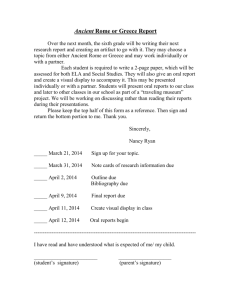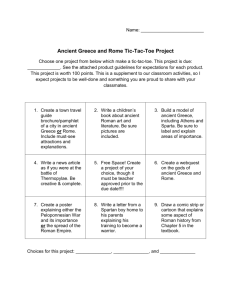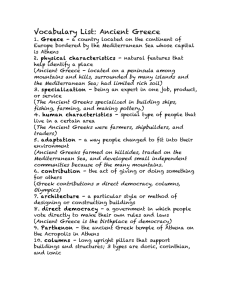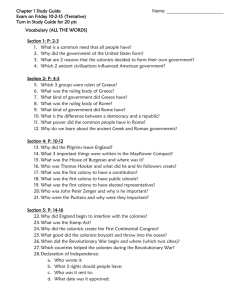A Visit to the Mediterranean Sea
advertisement
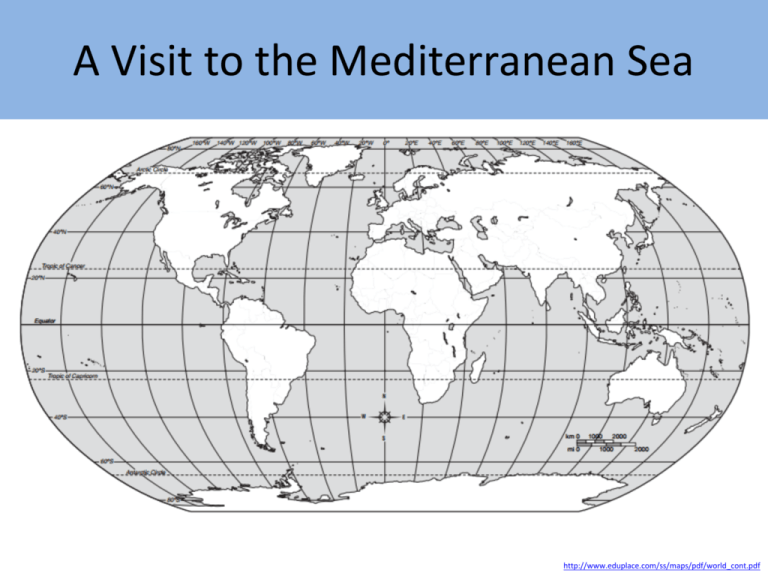
A Visit to the Mediterranean Sea http://www.eduplace.com/ss/maps/pdf/world_cont.pdf We will use this pathfinder to travel across the world to visit the Mediterranean Sea. There we will learn about the important part this body of water has played in the history and culture of the Earth. First, we’ll take at the Mediterranean Sea’s LOCATION. First try an ATLAS. On the Shelves… In a Database… On the Internet… (These sections are marked in our Library. You can also search in the online catalog.) (These can be accessed at school or home through the Library’s website.) (These sites can be accessed at school or home by opening the sites below.) The World Atlas is in the REFERENCE section of our school library. Culture Grams World Atlas Other atlases are found in the #912 section of NON-FICTION. SIRS Discoverer Maps of the World Infoplease Atlas Once you can locate the Mediterranean Sea, it’s time to look at a specific country. Each country along the sea uses the Mediterranean in a different way. You will want to look at the country’s HISTORY and GEOGRAPHY. Then try a BOOK. On the Shelves… Or and eBook… Or the Public Library (These sections are marked in our Library. ) (These books can be read at (You can read eBooks or school or at home through the reserve books online.) Library website.) Geography and History NON-FICTION books are shelved in the #900’s. Online Catalog You might also find a realistic fiction book set in one of these countries that will give you a different perspective. Try the Online Catalog. SIRS Discoverer (You can read Non-Fiction eBooks by selecting the link on the bottom right of the Home Page.) Virginia Beach City Public Library’s Website (This link takes you right to the catalog.) Try These. On the Shelves… Land and Resources of Ancient Greece by Melanie Ann Apel 938 APE Or and eBook… Or the Public Library… (these are all found in the SIRS Discoverer Database Non-Fiction Book link) Ancient Civilizations By Joe Fullman, YOUTH 930 F971A DK Eyewitness Early Humans Land and Resources of Ancient Rome by Daniel C. Gedacht 937 GED Land and Resources of Ancient Egypt by Leslie C. Kaplan 937 KAP Sightseers Ancient Egypt: A Guide to Egypt in the Time of the Pharoahs by Sally Tagholm 932 SIG Greece by Jim Bartell 949.5 BAR DK Eyewitness Pirate DK Eyewitness Invention Cultural Traditions in Greece by Lynn Peppas YOUTH 394.269495 P4241C Greece by Ann Heinrichs, YOUTH 949.5 H469G Life and Times in Ancient Rome by Mason, Conrad YOUTH 937 M3985L Gods and Warriors by Michelle Paver, YOUTH PAVER, M Ancient Egypt YOUTH 932.01 A541H You might want to explore one of these countries along the Mediterranean Sea further to understand life there and how it has changed over time. These sites will offer you more information. Next try a Database or Web Page. NASA Earth Observatory SIRS Discoverer Kids InfoBits (This site has satellite images of the Earth’s surface. I wonder how all that dust would affect travel.) (You can find encyclopedia and magazine articles, photographs, and videos here.) (This site is from the city Library. Try searching for the Mediterranean Sea.) National Geographic Mediterranean Sea Power Point Social Studies for Kids (This video link gives you an underwater view of life in the sea.) (This slide show is all about how people have used the Mediterranean Sea.) (This site has a lot of information on Greece and Rome.) World Wildlife Federation Mint National Geographic Kids (This site describes animals that live in the sea.) (This site describes how the Ancient Greeks traded on the sea.) (You can search this site for information, pictures, and videos.) Standards Virginia SOLs Geography 3.4 The student will develop map skills by a)locating Greece, Rome, and West Africa; b)describing the physical and human characteristics of Greece, Rome, and West Africa; c)explaining how the people of Greece, Rome, and West Africa adapted to and/or changed their environment to meet their needs. English 3.11 The student will write a short report. a) Construct questions about the topic. b) Identify appropriate resources. c) Collect and organize information about the topic into a short report. d) Understand the difference between plagiarism and using own words. 3.12 The student will use available technology for reading and writing. Common Core CCSS.ELA-Literacy.RI.3.10 By the end of the year, read and comprehend informational texts, including history/social studies, science, and technical texts, at the high end of the grades 2–3 text complexity band independently and proficiently. CCSS.ELA-Literacy.W.3.2 Write informative/explanatory texts to examine a topic and convey ideas and information clearly. CCSS.ELA-Literacy.W.3.7 Conduct short research projects that build knowledge about a topic. CCSS.ELA-Literacy.W.3.8 Recall information from experiences or gather information from print and digital sources; take brief notes on sources and sort evidence into provided categories. 21st Century Skills Skills 1.1.5 Evaluate information found in selected sources on the basis of accuracy, validity, appropriateness for needs, importance, and social and cultural context. Dispositions in Action 1.2.1 Display initiative and engagement by posing questions and investigating the answers beyond the collection of superficial facts. Responsibilities 1.3.2 Seek divergent perspectives during information gathering and assessment. Self-Assessment Strategies 1.4.1 Monitor own information-seeking processes for effectiveness and progress, and adapt as necessary.
